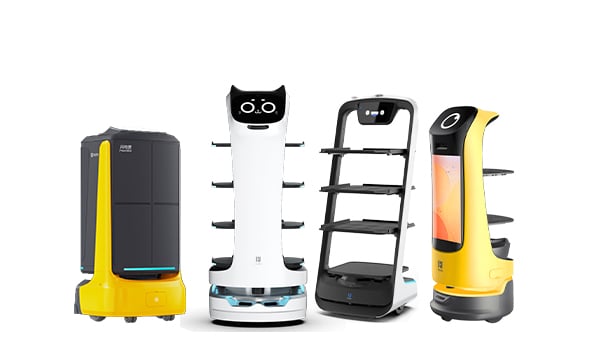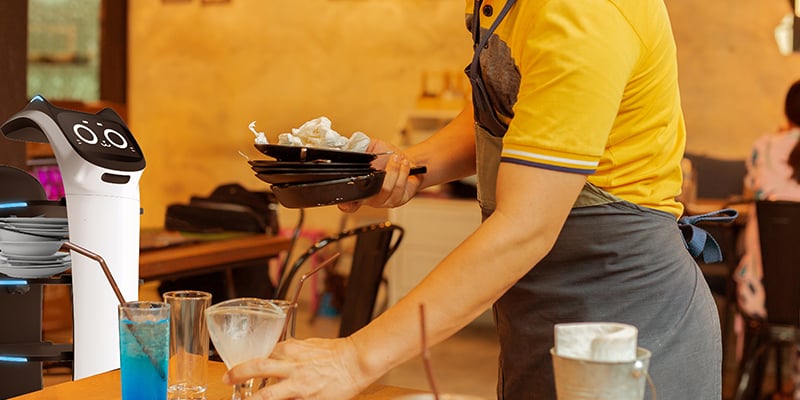By Shannon Flynn

Technology innovations are dramatically changing how the world works. Robots and other automated machines are opening countless possibilities that seemed impossible before. These new robot innovations are having a huge impact on a variety of different industries, from healthcare using them to improve practices to the automotive sector developing driverless cars. Since automated machines are becoming more popular, companies are investing more time and money into developing this new technology to stay ahead of the game.
Recently, the foodservice industry has seen a spike in automated machinery as well. These new automated trends are allowing the food and beverage industry to save money, make fewer mistakes, and reduce food waste.
Continue reading to learn more about how robots are benefiting the restaurant industry and what new technology advancements you could see in the future.
Automation in Restaurants
What is restaurant automation and why is it gaining such importance? Restaurant automation is the use of automated or robotic technology to complete tasks throughout the restaurant and facilitate different types of operations within a hospitality business. In other words, this technology would allow robots to simplify ordering, prepare meals, deliver food, and much more.
One example of a robot with significant potential to streamline the foodservice industry is PuduBot. A multi-robot dispatch system allows for painless collaboration, while the large carrying capacity cuts down on the human labor required to stay up and running.
Of course, the abilities these robots have are compelling – but there are still some limitations on what they can do.
Utilizing robotic technology in restaurants can be very beneficial. The effects they have are not limited to one area of the restaurant – they can improve all aspects of the business. Here are some benefits of automation in restaurants:
- Inventory time savings- Simplifies processes
- Reduces operational costs
- Fewer errors
- Reduces waste
- Contactless delivery
- Improves customer satisfaction
Robot Food Delivery
At one point in time, food delivery was traditionally used by quick-service restaurants. However, due to the global pandemic shutdowns, many restaurants – like fine dining establishments – had to adjust and develop delivery options. Some created in-house delivery infrastructure and others turned to third-party services like GrubHub and DoorDash.
Since COVID-19, online ordering and contactless delivery are continuing to grow. It is now becoming the new standard method for receiving food and other products.
With new robotic technologies becoming available rapidly, restaurants are trying to find the best ways to incorporate these advancements. Some of the advancements they are engaging in are drone delivery, small automatic robots in kitchens, and – before long at all – driverless cars to deliver the food the last mile to the customer.
There are several other automated delivery technology options that have created new opportunities for restaurant delivery services, too.
These touchless delivery systems promise to add a layer of safety to food handling. Again, because of the pandemic, touchless delivery options are becoming more popular because it makes consumers feel safer.
These food delivery robots will be able to carry meals to a specific delivery point and then notify the consumer when their food has arrived, making the delivery process more efficient and safer. FlashBot is a building delivery robot that can even take the elevator to reach its destination. It’s a great example of robots slowly but surely eliminating the physical barriers that have held them back so far.
Additionally, having food delivered by a robot or a driverless car is something most consumers have not yet experienced, but it’s an idea that is increasingly gaining their interest.
Automation in Restaurants Can Reduce Labor Costs
Automated machinery and robots are a great solution to assist labor shortages and overall reduce labor costs. While the price of robots may be expensive at first, its price will continue to drop as this technology progresses and becomes more common in the restaurant industry.
The industry may not be ready for fully automated restaurants yet – although examples approaching this are beginning to appear. However, there are already many case studies of restaurants successfully adopting automated robots to cook, plate, and serve food, with impressive returns on investment.
Beyond the robot's ability to complete tasks without getting paid, here are some other benefits that can reduce labor costs in the restaurant industry:
Automated inventory counting: These systems make it easier for employees to scan and track items for your kitchen, saving them time and helping reduce waste.
Repetitive tasks: Automating simple tasks makes food handling and preparation more efficient and cost-effective.
Reduce employee turnover: Robots can save time and money that would have been invested in recruiting and training a new hire. This time saved can be used to complete other tasks.
Safety: Robots provide a safer working environment and make fewer mistakes. They have the ability to perform dangerous jobs that humans shouldn’t perform, and can carry out deliveries more consistently and safely.
Customer appeal: BellaBot is one example of a robot specifically designed to provide an appealing, intuitive, and helpful experience. Robots could elevate dining out for guests and have them coming back.
Robots in Restaurants Are Redefining the Industry
Hotels, restaurants, fast-food delivery, and other service-based sectors have a lot to gain from robotics investments. Robots are not replacing employees, but instead providing an extra layer of assistance and consistency to the human employees working there.
Hotels, coffee shops, fast-food restaurants, and even artisanal eateries are turning to delivery robots to send materials from one work area to another and to ensure customers get their orders quickly – whether in-store or at home. It’s increasingly likely that the food service companies that make thoughtful use of automation are the ones that will thrive best in the coming years.
Discover more about Restaurant Robots with RobotLAB!

About the author

e-mail: shannonleighflynn@gmail.com

